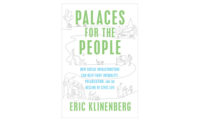Can Architecture Help Prevent Obesity?
For two years, AIA NY and city officials have studied and discussed how design can encourage physical activity and good health. Their findings are presented in the new book, Active Design Guidelines, which serves up practical advice to architects in NYC and beyond.


To combat obesity and related illnesses, New York City rolled out a first-of-its-kind guide this year to help designers create buildings and public spaces that encourage exercise.
Called “Active Design Guidelines: Promoting Physical Activity and Health in Design,” the 135-page document details how to get people walking more by encouraging the use of stairs or by adding parks outside buildings.
Though the guidelines are only advisory, they could still “really help us become healthier, to make sure that are cities are more livable, beautiful and sustainable,” said New York-based architect George Miller, president of the American Institute of Architects (AIA).
The result of a two-year collaboration between seven city agencies, in addition to the AIA, the guidelines were officially released on January 27. The book is $35 for a hard copy or free online.
As of late September, more than 4,500 copies had been downloaded to places as diverse as Afghanistan, Norway, and Uruguay, according to the city’s Department of Design and Construction (DDC). Meanwhile, about 850 hard copies have been distributed.
Area of Interest
Promoting activity seems to be an area of interest for New York architects. It was standing room only at the fifth “Fit City” conference, a four-hour event held in May at the Center for Architecture. The event drew about 350 attendees, including designers, city officials, developers, and doctors.
A similar event is planned for this spring, though organizers may broaden its focus to include suburban design, too. Obesity “needs to be addressed in all sorts of built environments, not just in urban ones,” says Victoria Milne, director of creative services at the DDC. She adds that a nonprofit center dedicated to promoting fitness is in the works as well.
The Active Design Guidelines book covers a range of topics. It dedicates nine pages on ways to make staircases more inviting, including better signage, lighting, and glass enclosures. Other sections, in a bid to encourage less driving, suggest how bus shelters might gain more seats than their current four.
Though constantly on-the-go New York might not immediately be associated with overweight people, 23 percent of the population is obese, according to the city, which can lead to diabetes, cancer, and heart disease.
Truly Effective?
Some worry that until the guidelines become embedded in building codes, they won’t have much bite.
“I’ve been around the block too many times to pin my hopes on good intentions,” says Thomas Balsley, FASLA, who has designed 75 New York parks, like Riverside Park South in Manhattan and Gantry Plaza Sate Park, which aided in the transformation of an industrial section in Long Island City, Queens. Many of those places, Balsley pointed out, prod their visitors to stretch their legs through strategically placed inclines.
Nevertheless, in a world increasingly focused on healthcare costs, adding any of these improvements voluntarily, particularly to apartment buildings, could become a valuable sales pitch for residents.
“It could be an amenity, like kitchen finishes,” says Robyne Kassen, co-founder of Urban Movement Design. At Fit City, she presented slides of bus shelters created for the 2010 Winter Olympics that substitute dimpled boulder-like forms for benches, to let athletes recline while propping up their backs. “The guidelines act as a point of awareness,” Kassen said, “but it is just the beginning.”




